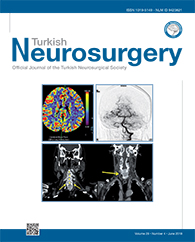MATERIAL and METHODS: A total of 40 patients with fourth ventricular tumors were treated via the telovelar approach between 2005 and 2014.
RESULTS: The telovelar approach provided adequate exposure in all patients. The brainstem and posterior inferior cerebellar artery (PICA) were identified early and preserved in all patients. Potential tumor attachment was observed at the floor of the fourth ventricle in 22 (55%) patients: five had brainstem glioma, while 16 of the remaining 17 (94%) had focal attachments at any area of the caudal fourth ventricular floor, and two (11.7%) had attachments at any area of the lateral aspect of the rostral fourth ventricular floor, which was the only point of attachment in one. None of these tumors infiltrated the area of the cerebral aqueduct. Gross total excision was achieved in 45% of patients and near total excision was possible in 25% due to focal tumor attachment at one or more of the previously mentioned areas. However, debulking was possible in 30%.
CONCLUSION: The telovelar approach provides the advantages of early identification and preservation of the brainstem and PICA, and allows for assessment of potential tumor attachment at the aforementioned areas. This is in contrast to the traditional consideration of vermian preservation, which is impossible to achieve regardless of the approach in patients with large tumors infiltrating the vermis. The pathological nature of the tumor and the degree of brainstem infiltration were key factors that determined the degree of tumor excision.
Keywords : Children, Fourth ventricular surgery, Posterior fossa tumor, Telovelar approach




